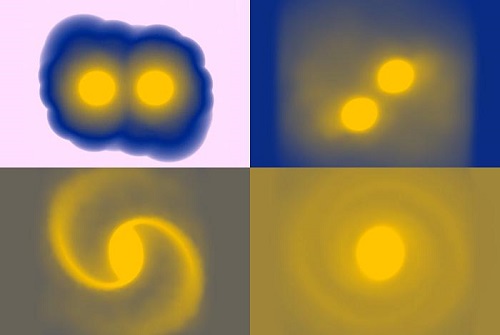Los Alamos supercomputers help interpret the latest LIGO findings

Gravitational-wave observation confirms heavy-elements theory
Astrophysicist Chris Fryer was enjoying an evening with friends on August 25, 2017, when he got the news of a gravitational-wave detection by LIGO, the Laser Interferometer Gravitational-wave Observatory. The event appeared to be a merger of two neutron stars -- a specialty for the Los Alamos National Laboratory team of astrophysicists that Fryer leads. As the distant cosmic cataclysm unfolded, fresh observational data was pouring in from the observation -- only the fifth published since the observatory began operating almost two years ago.
"As soon as I heard the news, I knew that understanding all of the implications would require input from a broad, multi-disciplinary set of scientists," said Fryer, who leads Los Alamos' Center for Theoretical Astrophysics. Fryer's colleagues, Ryan Wollaeger and Oleg Korobkin, outlined a series of radiation transport calculations and were given priority on Los Alamos' supercomputers to run them. "Within a few hours, we were up and running."
They soon discovered the LIGO data showed more ejected mass from the merger than the simulations accounted for. Other researchers at Los Alamos began processing data from a variety of telescopes capturing optical, ultraviolet, x-ray, and gamma-ray signals at observatories around the world (and in space) that had all been quickly directed to the general location of the LIGO discovery.
The theorists tweaked their models and, to their delight, the new LIGO data confirmed that heavy elements beyond iron were formed by the r-process (rapid process) in the neutron-star merger. The gravitational wave observation was having a major impact on theory.
They also quickly noticed that, within seconds of the time of the gravitational waves, the Fermi spacecraft reported a burst of gamma rays from the same part of the sky. This is the first time that a gravitational wave source has been detected in any other way. It confirms Einstein's prediction that gravitational waves travel at the same speed as gamma rays: the speed of light.
When neutron stars collide
The gravitational wave emission and related electromagnetic outburst came from the merger of two neutron stars in a galaxy called NGC 4993, about 130 million light-years away in the constellation Hydra. The neutron stars are the crushed remains of massive stars that once blew up in tremendous explosions known as supernovas.
With masses 10 and 20 percent greater than the sun's and a footprint the size of Washington, D.C., the neutron stars whirled around each other toward their demise, spinning hundreds of times per second. As they drew closer like a spinning ice skater pulling in her arms, their mutual gravitational attraction smashed the stars apart in a high-energy flash called a short gamma-ray burst and emitted the tell-tale gravitational wave signal. Although short gamma-ray bursts have long been theorized to be produced through neutron star mergers, this event -- with both gamma-ray and gravity wave observations -- provides the first definitive evidence.
With Los Alamos's cross-disciplinary, multi-science expertise, the Los Alamos team was geared up and ready for just such an event. Laboratory researcher Oleg Korobkin is the lead theory author on a paper released yesterday in Science, while the Lab's Ryan Wollaeger is the second theory author on a paper released yesterday in Nature.
Beyond that theory work, though, Los Alamos scientists were engaged in a broad range of observations, astronomy, and data analysis tasks in support of the LIGO neutron-star discovery. Because the Laboratory's primary mission centers on the nation's nuclear stockpile, Los Alamos maintains deep expertise in nuclear physics and its cousin astrophysics, the physics of radiation transport, data analysis, and the computer codes that run massive nuclear simulations on world-leading supercomputers. In other words, the Laboratory is a logical partner for extending LIGO discoveries into theories and models and for confirming the conclusions about what the observatory discovers.
